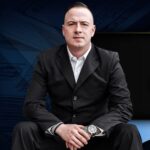Team USA Goalball: Training in the Heart of Paris

As Matt Simpson strolls off the goalball court, balls echo throughout the gymnasium. Simpson is sporting a black eye while his teammates continue practicing. The room is chaotic and the energy is high, but the most notable part of this room is that nobody is in it but Team USA Goalball.
For the first time, it’s all theirs.
The United States delegation’s High Performance Center is a state-of-the-art training compound located in the quiet suburb of Eaubonne, 10 miles (15 kilometers) north of Paris.
U.S. Olympic athletes have had access to this type of exclusive facility since 2008. Now, Paralympians do, too.
“I think that (the HPC) is one of the biggest changes I’ve seen,” said Dana Schoenwetter, games operations director at the U.S. Olympic & Paralympic Committee. “The equity in the support to our Olympians and Paralympians, it’s been great.”
Track and field medalist Jarryd Wallace agreed that having access to the HPC this year is a significant upgrade.
“I think the best part about this experience compared to my first three games is having access to the High Performance Center,” said Wallace, who is competing in the long jump after representing the U.S. in the sprints in the Paralympics in Tokyo, Rio and London. “We get this facility to ourselves, Team USA, which is amazing.”
First-time Paralympians, like sitting volleyball libero Sydney Satchell, are also excited to have a space to train while connecting with Team USA athletes outside of their respective sports.
“It’s fun for somebody who is new to the Paralympic Games to meet new people, see people I’ve seen on commercials and billboards, but also get in that mindset, game ready,” Satchell said.
Exclusive Haven for Team USA Athletes
Six years ago, staff members from the USOPC traveled to Paris on the hunt for a facility to host one of the largest teams to compete in the Games. After two days and around 30 venue tours, they chose Athletica, a multisport training facility used by Eaubonne community members.
Team USA recently invested 27 million euros ($29 million) in renovations targeting the HPC’s dormitories, sports medicine facilities, and training centers in preparation to host approximately 1,200 athletes across both the Olympic and Paralympic Games. The athletes village is 10 miles (15 kilometers) away, allowing easy travel between the facilities.
Exclusive access to the compound allows athletes to train on their own schedule. Unlike the Paralympic Village where 8,000 athletes share approximately 300 pieces of equipment, Team USA athletes have the luxury of having their own facility. This dedicated training space makes a significant difference in their preparation.
“We have this court whenever we want, we don’t have to wrestle with the Chinese team for a court slot,” said goalball athlete Simpson. “We don’t have to worry about any logistics, we just show up and play.”
That is exactly what Schoenwetter and her team envisioned when deciding whether to keep the HPC open for the Paralympics.
“Giving them a competitive edge with their training and preparation for the Games, to us that’s important,” Schoenwetter said. “That’s why we’re here.”
Enhancing the Athlete Experience
The USOPC has equipped the HPC with the same amenities available at the Colorado Springs facility, including nutrition specialists, kinesthesiology services, and sports psychologists. This focus on consistency and familiarity ensures that each athlete can maintain their training regimen.
Simpson, who has worked with the same dietician, Kate Davis, for almost six years, emphasizes the importance of having a familiar face in a new environment.
“Having her with us in practice and on the ground here, (she is) helping us develop the habits and knowledge necessary to really take those extra few percentages forward that really matter,” said Simpson. “It’s a way to feel comfortable, a way to stay on task, a way to stay in our routine even as everything around us changes.”
Despite these positives, Schoenwetter acknowledges that not all Paralympians have utilized the facility. Looking ahead to the 2028 Los Angeles Games, the USOPC is considering strategies to increase engagement and encourage Paralympians to take full advantage of the next HPC.
“Now moving forward to LA, we have a good base to kind of grow from and ways we can support better,” Schoenwetter said.
Ana Escamilla and Julianna Russ are students in the undergraduate certificate program in the Carmical Sports Media Institute at the University of Georgia.
Copyright 2024 The Associated Press. All rights reserved. This material may not be published, broadcast, rewritten, or redistributed without permission.






